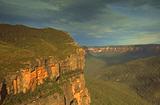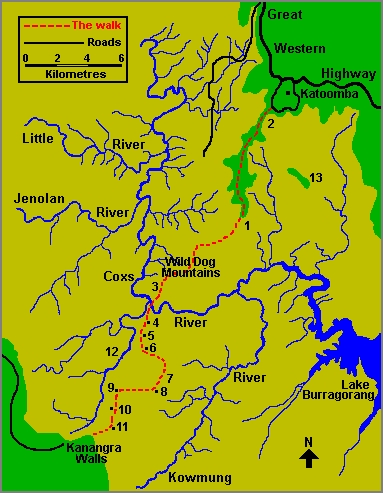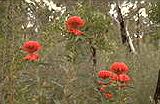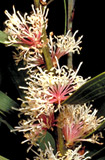|
[Front Page] [Features] [Departments] [SGAP Home Page] [Subscribe]

Blue Mountains Wilderness
Harry Loots
The Blue Mountains are close to Sydney and seem tame in comparison to other wilderness areas. But bushwalkers still manage to get lost, suffer from heat exhaustion or even hypothermia in this rugged
environment. As most people manage to enjoy themselves on many of the well tramped on tracks the Mountains are popular with all types of walkers.
Today there is still as much wilderness experience to be enjoyed as there was in the early days of Sydney's settlement. Then, crossing the Blue Mountains was a challenge to explorers. Indeed part of the romance of the Blue Mountains is its place in Australia's colonial history. They were the barriers that had to be conquered before "civilization" could expand West. Once crossed, Sydney became wealthy from the West's sheep and gold. The first European to cross was probably John Wilson, the escaped convict, who accompanied Aboriginals through the Mountains in 1797. However the first "official" crossing in 1813 was carried out by the influential Misters Blaxland, Lawson and Wentworth. These three explorers had only seen Aboriginals in the distance and would have made better progress using their local knowledge.
The Blue Mountains were difficult to cross because those following the rivers West would be stopped by ramparts formed by sheer sandstone cliffs that drop from the high plateau. Driving across the Blue Mountains today, on evenly graded roads, it is difficult to imagine the steep paths of earlier travellers. But as soon as you get off the highway the true nature of the Mountains is revealed.
In September I fulfilled a 30 year dream. Lindy and I experienced the downs and ups of the Katoomba to Kanangra Walls walk. This involved long days of walking along Narrow Neck out from Katoomba, through the
Wild Dog Mountains, down to cross the Coxs River, up Mount Strongleg and then more ups and some downs to Mount Cloudmaker, Mount Stormbreaker, Mount High and Mighty, Mount Berry to finally reach the high plateau of Kanangra Walls. The distance we covered in a day was governed by the availability of water. This is a ridge walk and while it rains throughout the year in the Mountains there are only a few places where reliable water can be found. The ridges are mostly extremely exposed and dry but there are hanging swamps at the headwaters of creeks. Here groundwater seeps out to collect in pools that often balance on the impermeable rock of cliff edges.
 |
Sandstone Cliffs were a barrier to European exploration for many years following the first settlement in 1788. Select the thumbnail image or highlighted name for a higher resolution image (26k).
|
 |
Narrow Neck Plateau juts out from the main Blue Mountains ridge, separating the Jamison and Megalong Valleys. Select the thumbnail image or highlighted name for a higher resolution image (32k). Photo: Sydney Water
|
We were lucky with the weather. It had rained solidly for five days in the previous week. The water at Mobbs Soak and Dex Creek, hanging swamps high on the ridges, was plentiful. A cool Westerly wind ensured clear skies and lower temperatures. The air was so clear that we saw Sydney's central business district towers, 90 kilometres to the east, while walking along Narrow Neck. Our only concern was the level of the Coxs River. Rain had swollen the river and on our first day we met a group of teenagers who had failed to cross. One fellow had been washed over rocks but had no injuries. As the Coxs River has only a small catchment, not extending beyond Wallerawang to the north, we hoped that the river level would fall as rapidly as it had risen.
The colours of Spring were a bonus of this walk. On Narrow Neck two metre high solid masses of pink bloom were borne on Boronia ledifolia. Groups of red waratah (Telopea speciosissima) glowed like red traffic lights in the Narrow Neck forest of eucalypts, banksias (B.marginata, B.spinulosa, B.serrata) and broad-leaf geebung (Persoonia levis). On more exposed positions, near the 100 metre high sheer cliffs that drop off both sides of Narrow Neck, mauve star shaped flowers appeared on the ends of low Philotheca salsolifolia branches. Tiny white bell shaped flowers bloomed, like sticks of white coral, along the stems of different species of heath (Epacris microphylla, E.obtusifolia) in wetter places. Climbing off the end of Narrow Neck at Taros Ladder we found a rare plant. As we climbed down the cliff face I saw the small deep pink bell shaped heath flowers of Epacris reclinata growing out of a rock crevice.
 
Narrow Neck Plateau to Kanangra Walls
Legend
- Taros Ladder
- Narrow Neck
- Yellow Pup Ridge
- Mt Strongleg
- Kullieatha Peak
- Mt Amarina
- Gangerang Plateau
- Mt Cloudmaker
- Mt Stormbreaker
- Mt High and Mighty
- Mt Berry
- Kanangra Gorge and Creek
- Mt Solitary
The walk took us from poorly drained exposed positions to closed forests, to open forests on exposed ridge-lines and to the poorly drained but protected hanging swamps. Each of these ecosystems had its own unique variety of plants. Each presented its own individual colours and plantscape. Geebung (Persoonia), a small tree easily identified by its dark thin flaky bark and moderate (3 metre) height, grows in both closed forests and open forests. However while broad-leaf geebung (P.levis) with its large (4 cm wide) bright green leaves is found in closed forests narrow-leaf geebung (P.linearis) grows in open forests. In areas where there is a transition from closed to open forest both geebung species are found.
 |
Epacris reclinata is usually found clinging to exposed cliffs. It is found in the western parts of the Blue Mountains. Select the thumbnail image or plant name for a higher resolution image (29k).
|
The ridges are at the mercy of both wind and fire. Narrow-leaf geebung grew on the very dry and exposed Yellow Pup and Mount Strongleg Ridges which lead down to the Coxs River. It also grew on the stony line of ridges formed by Mount Cloudmaker, Mount Stormbreaker, Mount High and Mighty and Mount Berry. Here a combination of thin (skeletal) sandy porous soils, exposed bedrock and steep valley sides has resulted in little water being retained for plant use. Black ash (Eucalyptus sieberi) with its rough very dark furrowed bark, glistening with resin, are small and bent in this open forest. Trees that grew too high have been blown over and lie broken on the ground.
Fire frequently races across the ridges leaving black trunks in contrast to the bright yellows, pinks and purples of Spring flowers. Fire has repeatedly denuded hillsides of protective vegetation so that follow up rains have washed away nearly all nutrients from the soils. But nitrogen fixing pea plants are in abundance on these poor soils. Bitter pea (Daviesia squarrosa) appeared as metre high belts of yellow flowers that ran between the widely spaced charcoal covered tree trunks. Its small yellow flowers with red centres hide hard sharp leaves that pricked when touched. There were pink areas caused by smooth Darling pea (Swainsona galegifolia) which grew up to a metre. The purple flowers of the pea plant false sarsaparilla (Hardenbergia violacea) trailed around the forest floor.
On windy ridges white cotton threads of lichen hung off small shrubs while green scales of lichen covered stems. Grey weathered boulders were brightened by droll splashes of orange lichen. On the long stony ridges from Kullieatha Peak to Mount Amarina, long brown grass skirts modestly hid three metre tail thick black trunks of grass trees (Xanthorrhoea sp.). Gnarled grass trees stood like silent sentinels on the almost bare stony knolls Rip, Rack, Roar and Rumble. In between the rocks, conesticks (Petrophile pulchella) with upright spiky leaves and one metre high white-beard (Leucopogon sp.) decorated with masses of small white bells, survived.
 |
The New South Wales waratah, Telopea speciosissima shines like a beacon in the Blue Mountains forests. Select the thumbnail image or plant name for a higher resolution image (32k).
|
 |
The fringe myrtle, Calytrix tetragona is a small shrub which is found in many parts of southern Australia. Select the thumbnail image or plant name for a higher resolution image (30k).
|
At the end of each dry day we sought water. Our thirst was relieved at Mobbs Swamp by water standing in shallow rock pools. The swamp's water-logged peat at the head of Warrigal Creek featured a knee-high sea of starry white flowers on fringe-myrtle (Calytrix tetragona) mixed with the sharp yellow seed spikes of kangaroo grass (Lomandra longifolia). Tight impenetrable low thickets of paperbark (Melaleuca linariifolia) grew in standing water. We camped in a clearing of the surrounding forest of broad-leaf and narrow-leaf geebung and tall eucalypts.
At Dex Creek we camped in a high open valley next to a small stream congested with thickets of woolly tea-tree (Leptospermum lanigerum). Water from surrounding high swamps dripped down valley sides covered with fern (Gleichenia dicarpa) and corel heath (Epacris microphylla). On the dry North facing side of the valley banksia (B.marginata, B.serrata) and broad-leafed hakea (H.dactyloides) grew in low clumps amongst large boulders. This gave us an open sky to watch the stars that night.
 |
Hakea dactyloides is a common large shrub of the Blue Mountains. This pink form, however, is unusual. Select the thumbnail image or plant name for a higher resolution image (32k).
|
Off the ridges, along the slopes of the Wild Dog Mountains and on the Gangerang Plateau, the forest was taller and darker. Protected from winds, with deep clay soils, plants grew taller, had broader leaves and there was less evidence of fire. The ubiquitous broad-leaf geebung (Persoonia levis) with its wide bright green leaves favoured this closed forest with a large population. The forest floor was both darkened and littered by tall eucalypts and she oaks (Allocasuarina littoralis). Tall and elegant manna gums (Eucalyptus viminalis) filled the forest floor with streamers of bark that had peeled off trunks as long thin ribbons. She Oak towered above large boulders to cover the forest floor with brown needles. Complementing these brown tones were the subtle shades of lilac flowers on mint bush (Prostanthera prunelloides) that grew two metres tall in shady glens. Rays of yellow were cast through the bush by large yellow golden glory pea flowers (Gompholobium latifolium) and ground hugging buttercups on guinea flower (Hibbertia diffusa) which scrambled about the forest floor. On a brighter but sheltered slope under Crafts Wall pinks were exhibited by two metre high long-leaf waxflowers (Eriostemon myoporiodes).
With an opening the forest canopy ferns and grasses coloured the forest floor. Fields of nodding blue lilies (Stypandra glauca) with blue petals and woolly yellow filaments were on metre long grassy stalks. The spreading short stemmed twisted mat-rush (Lomandra oblique) were numerous. Among the rocks above Dex Creek flowers with three large fragile purple petals heralded small grassy clumps of wild iris (Patersonia sericea). Black-eyed Susan (Tetratheca thymifolia) cast its eyes downwards but flashed its dark pink petals as it spread over the forest floor.
The challenge of this walk was not limited to long days of walking. Crossing the river proved to be an exciting experience. The Coxs River is deep and wide at its junction with Kanangra Creek and after the rain it was running high. A tall stand of river oak (Casuarina cunninghamiana) growing in sands formed a large island round which the river cascaded as white water over rounded river stones. After some confused walking about and wading into very deep water we decided that the calm immediately before the rapids at the head of the island was to be our crossing point. Although the depth was only 70 centimetres the force of the stream was very strong. Each step was carefully calculated to maintain our balance so as not to be swept downstream. At a metre the river would have been too dangerous to cross.
That night we camped on the grassy flats of Kanangra Creek relieved that we had crossed the river and were now able to dry our boots near the fire. In the early evening a cool breeze blew down the valley from the mountains above but by midnight the air was still and we awoke next morning to birdcalls and a heavy dew. Later we saw Kanangra Creek from above as we looked down into its Gorge from the mountain tops. We saw waterfalls plunge off 100 metre sheer cliffs as we stood on massive walls of sandstone 500 metres above the creek. This was a walk on which we enjoyed the wilderness with its spectacular scenery, beautiful flora and challenging physical experiences.
From the April 1997 issue of the newsletter of the Harbourside Group of SGAP

[Front Page] [Features] [Departments] [SGAP Home Page] [Subscribe]
Australian Plants online - June 1998
The Society for Growing Australian Plants
|